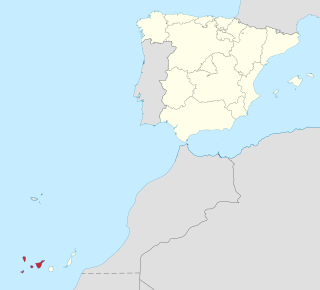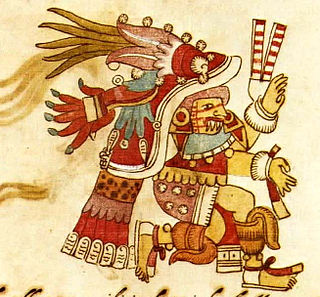
Guayota, in Guanche mythology of Tenerife (the Canary Islands), was the principal malignant deity and Achamán's adversary.

Guayota, in Guanche mythology of Tenerife (the Canary Islands), was the principal malignant deity and Achamán's adversary.
According to Guanche legend, Guayota lived inside the Teide volcano, one of the gateways to the underworld. He was said to be represented as a black dog and was accompanied by demons, also in the form of black dogs, known as tibicenas.
According to legend, Guayota kidnapped Magec (the sun) and shut it up in Teide, plunging the world into darkness. Humans prayed to Achamán who saved Magec and instead locked Guayota up in Teide. Guayota is the king of evil genies, and was part of Guanche mythology.
Guayota shares features similar to other malignant deity-inhabitants of volcanoes as in the case of the goddess Pele in Hawaiian mythology, who lived in the Kīlauea volcano and was regarded by the native Hawaiians as responsible for the eruptions of the volcano. [1]
Currently, like other aboriginal gods, Guayota remains a typical Canary creature folklore. His evocation is present in many and varied elements of popular culture:

The Canary Islands, also known informally as the Canaries, are a Spanish autonomous community and archipelago in Macaronesia in the Atlantic Ocean. At their closest point to the African mainland, they are 100 kilometres west of Morocco. They are the southernmost of the autonomous communities of Spain. The islands have a population of 2.2 million people and are the most populous special territory of the European Union.

Province of Santa Cruz de Tenerife, also Province of Santa Cruz, is a province of Spain, consisting of the western part of the autonomous community of the Canary Islands. It consists of about half of the Atlantic archipelago: the islands of Tenerife, La Gomera, El Hierro, and La Palma. It occupies an area of 3,381 km2 (1,305 sq mi). It also includes a series of adjacent roques.

The Guanches were the indigenous inhabitants of the Canary Islands in the Atlantic Ocean some 100 kilometres (60 mi) west of the North African coast. They spoke the Guanche language, which went extinct in the 17th century and is believed to have been related to Berber languages.

In Hawaiian religion, Pele is the goddess of volcanoes and fire and the creator of the Hawaiian Islands. Often referred to as "Madame Pele" or "Tūtū Pele" as a sign of respect, she is a well-known deity within Hawaiian mythology and is notable for her contemporary presence and cultural influence as an enduring figure from ancient Hawaii. Epithets of the goddess include Pele-honua-mea and Ka wahine ʻai honua.

Tenerife is the largest and most populous island of the Canary Islands. It is home to 43% of the total population of the archipelago. With a land area of 2,034 square kilometres (785 sq mi) and a population of 978,100 inhabitants as of January 2022, it is also the most populous island of Spain and of Macaronesia.

La Palma, also known as La isla bonita and officially San Miguel de La Palma, is the most northwesterly island of the Canary Islands, Spain. La Palma has an area of 708 square kilometres (273 sq mi) making it the fifth largest of the eight main Canary Islands. The total population at the end of 2020 was 85,840, of which 15,716 lived in the capital, Santa Cruz de La Palma and about 20,467 in Los Llanos de Aridane. Its highest mountain is the Roque de los Muchachos, at 2,423 metres (7,949 ft), being second among the peaks of the Canaries after the Teide massif on Tenerife.

El Hierro, nicknamed Isla del Meridiano, is the second-smallest and farthest-south and -west of the Canary Islands, in the Atlantic Ocean off the coast of Africa, with a population of 10,968 (2019). Its capital is Valverde. At 268.51 square kilometres (103.67 sq mi), it is the second-smallest of the eight main islands of the Canaries.

Teide, or Mount Teide, is a volcano on Tenerife in the Canary Islands, Spain. Its summit is the highest point in Spain and the highest point above sea level in the islands of the Atlantic. If measured from the ocean floor, its height of 7,500 m (24,600 ft) makes Teide the third-highest volcano in the world, and is described by UNESCO and NASA as Earth's third-tallest volcanic structure. Teide's elevation above sea level makes Tenerife the tenth highest island in the world.

La Orotava is a town and a municipality in the northern part of Tenerife, one of the Canary Islands of Spain. The area of the municipality stretches from the north coast to the mountainous interior, and includes the summit of the Teide volcano, Canary Islands' and Spain's highest point at 3,718 m. At 207.31 km2, it is the largest municipality of the island of Tenerife. The population is 41,255 (2013).

Garajonay National Park is located in the center and north of the island of La Gomera, one of the Canary Islands (Spain). It was declared a national park in 1981 and a World Heritage Site by UNESCO in 1986. It occupies 40 km2 and it extends into each of the six municipalities on the island.
Abora is the name of an ancestral solar deity of La Palma and a traditional god of the Guanches.

Teide National Park is a national park located in Tenerife, Canary Islands, Spain.
A Tibicena, also known as Guacanchas, was a mythological creature of the Guanches, pre-Hispanic inhabitants of the Canary Islands. Tibicenas were imagined to be demons or genies who had the bodies of great wild dogs with red eyes, covered by long, black fur. They lived in deep caves inside the mountains.

The Virgin of Candelaria or Our Lady of Candle, popularly called La Morenita, celebrates the Virgin Mary on the island of Tenerife, one of the Canary Islands (Spain). The center of worship is located in the city of Candelaria in Tenerife. She is depicted as a Black Madonna. The "Royal Basilica Marian Shrine of Our Lady of Candelaria" is considered the main church dedicated to the Virgin Mary in the Canary Islands and she is the patron saint of the Canary Islands. Her feast is celebrated on February 2 and August 15, the patronal feast of the Canary Islands.

Museo de la Naturaleza y Arqueología (MUNA), is a museum-based in Santa Cruz de Tenerife, Tenerife,. It contains many significant archaeological finds and is considered the best repository of objects from the Pre-Castilian Canary Islands. The museum also houses significant paleontological, botanical, entomological, and marine and terrestrial vertebrate collections, and is considered the best Natural Library of the Canary Islands.
Achamán is the supreme god of the Guanches on the island of Tenerife; he is the father god and creator. The name means literally "the skies", in allusion to the celestial vault.
Magec, in Tenerife, was a deity in the ancient Berber mythology. Magec was god or goddess of the Sun and light and is thought to be one of the principal divinities in the Guanche religion. According to legend, Magec was captured by Guayota and held prisoner inside Teide before later being liberated by Achamán.
The Beñesmen or Beñesmer was the most important festival of the ancient aborigines of the Canary Islands, mainly between the Guanches of the island of Tenerife. It was the feast of the harvest, it ordered Aboriginal affairs materials, and celebrated, venerated cultural and spiritual traditions. He was considered the "New Year", which coincided with the collection of the harvest. They were held during the first moon of August. Beñesmen was also the name with which the Guanches knew the month of August.
As in the rest of Spain, the majority religion in the Canary Islands is the Catholic Church. The Catholic religion has been the majority since the Conquest of the Canary Islands in the fifteenth century. This religion would largely replace the Canarian aboriginal religion through the prohibition of the latter and syncretism. According to a survey conducted in 2019, Canary Islands is the fifth autonomous community in Spain with the highest percentage of people who declare themselves to be Catholics after the Region of Murcia, Extremadura, Galicia, Aragon, and Castile and León. 76.7% of the population is Catholic.

A volcano deity is a deification of a volcano. Volcano deities are often associated with fire, and are often represented as fire deities as well. The following is a list of volcano deities:
guayota y pele.